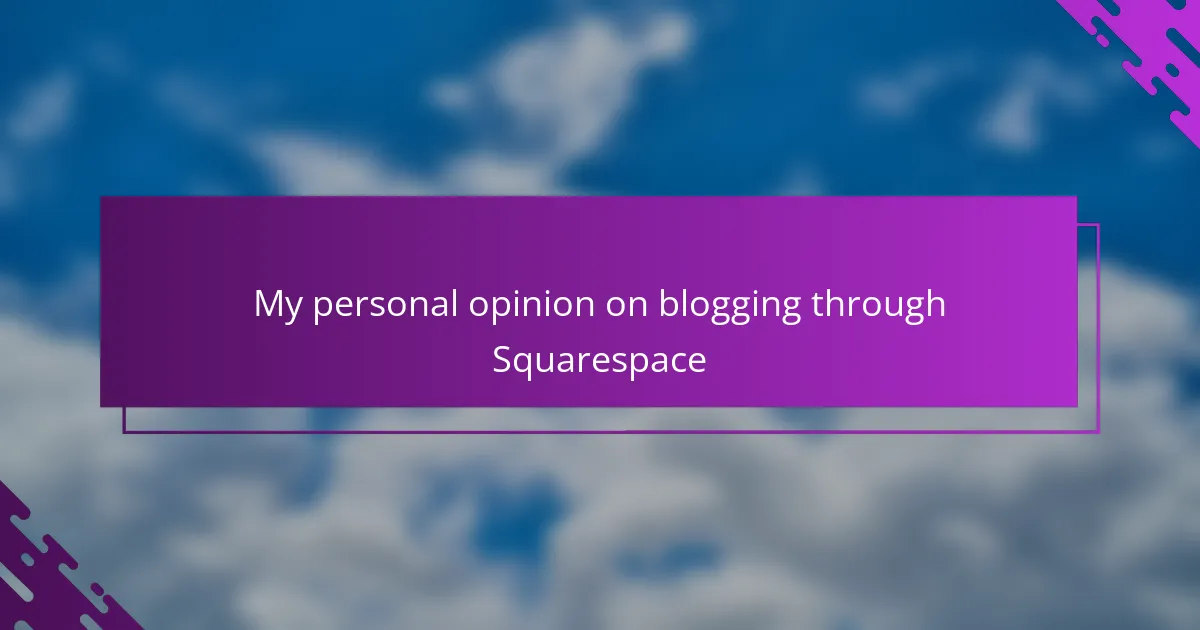Key takeaways
- Personal blogging provides a platform for self-expression and emotional reflection, creating a unique connection between the writer and their audience.
- Squarespace is user-friendly for bloggers, offering customizable templates and seamless tools that streamline the writing and publishing process.
- Effective blog design emphasizes simplicity, quality imagery, and thoughtful typography to enhance reader engagement.
- Authenticity and consistency in content, along with analyzing reader engagement, are key strategies for successful blogging.
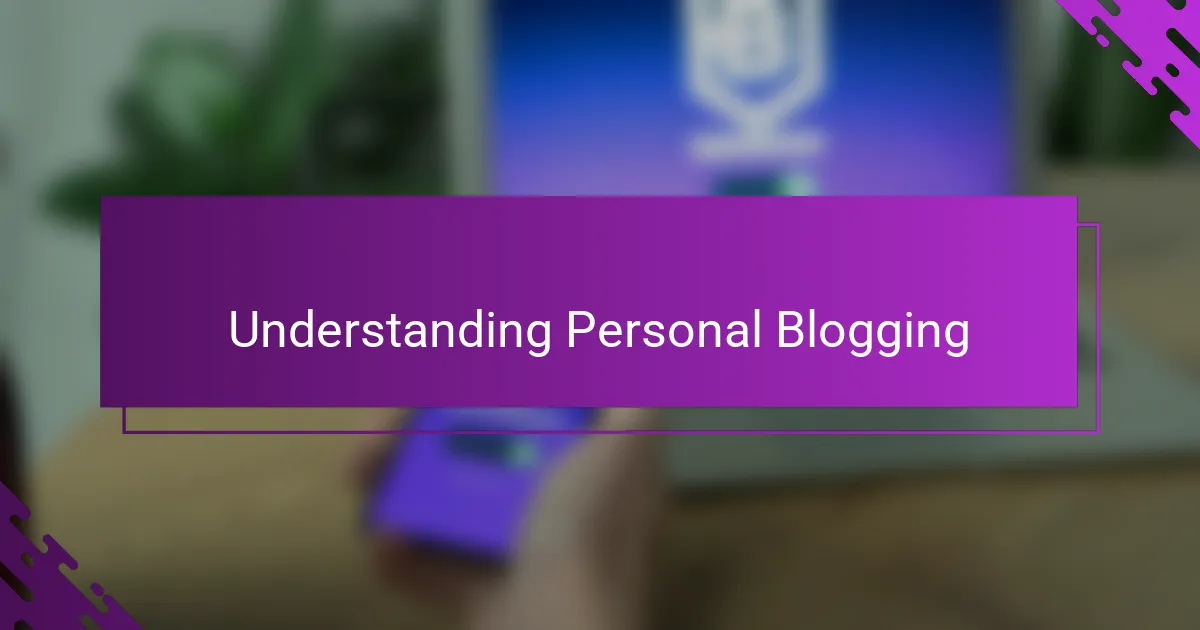
Understanding personal blogging
Personal blogging, to me, is like having a conversation with a friend who’s always ready to listen. It’s a space where I can express thoughts, share experiences, and reflect without worrying about judgment. Have you ever found yourself wanting to capture a moment or emotion that feels too personal for social media? That’s exactly where personal blogging fits in.
I’ve noticed that personal blogging goes beyond just writing; it’s about creating a connection. When I read or write a heartfelt post, it feels like a bridge between my inner world and the outside one. It makes me wonder—how often do we get to be truly open in our daily lives?
Sometimes, personal blogging serves as a mirror. When I blog, I’m not just telling a story; I’m learning about myself through each sentence. It’s a process of understanding who I am, my values, and what matters most—doesn’t that make writing feel a bit like therapy?
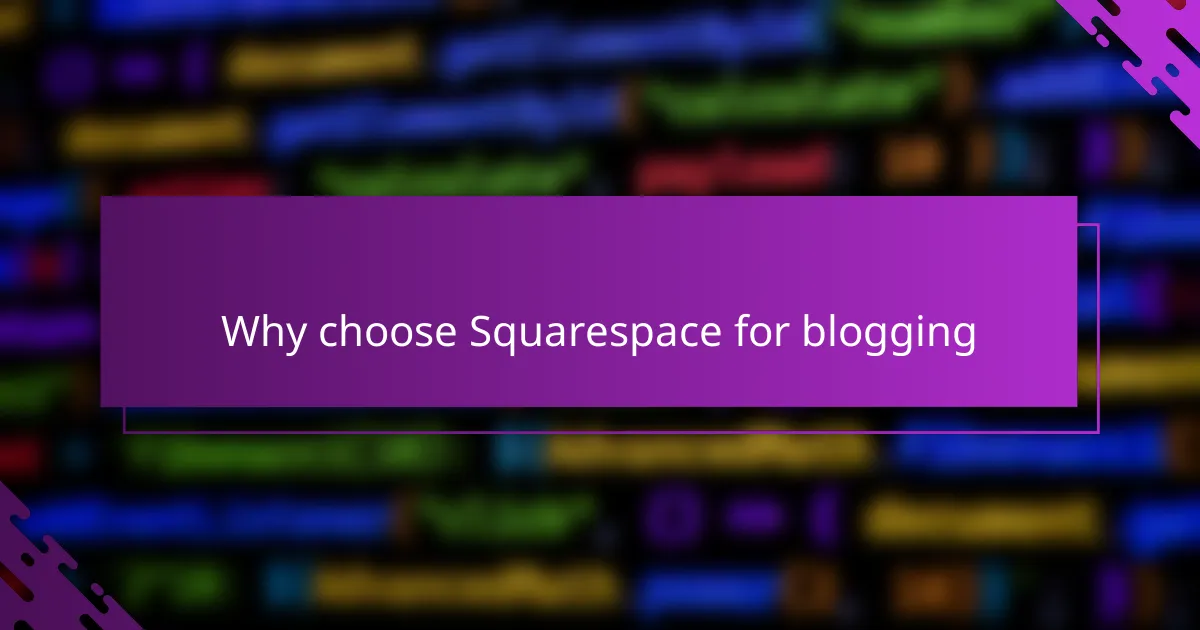
Why choose Squarespace for blogging
Choosing Squarespace for blogging felt like finding the right home for my words. The platform’s sleek, professional templates made it easy for me to create a space that truly reflected my style without the frustration of complicated design work. Have you ever struggled with a blog that looks more like a jumble than a story? Squarespace solved that for me.
I also appreciate how seamless the blogging tools are. From scheduling posts to organizing categories, it’s all intuitive, which keeps me focused on writing rather than wrestling with technical details. Does anything kill your creative flow faster than a clunky editor? For me, smooth workflows mean more time for meaningful content.
What’s more, the built-in analytics gave me insights into how my posts resonate with readers, which felt like having a conversation beyond just the words on the screen. Isn’t it comforting to know that what you share actually connects? That connection is precisely why Squarespace became my blogging companion.
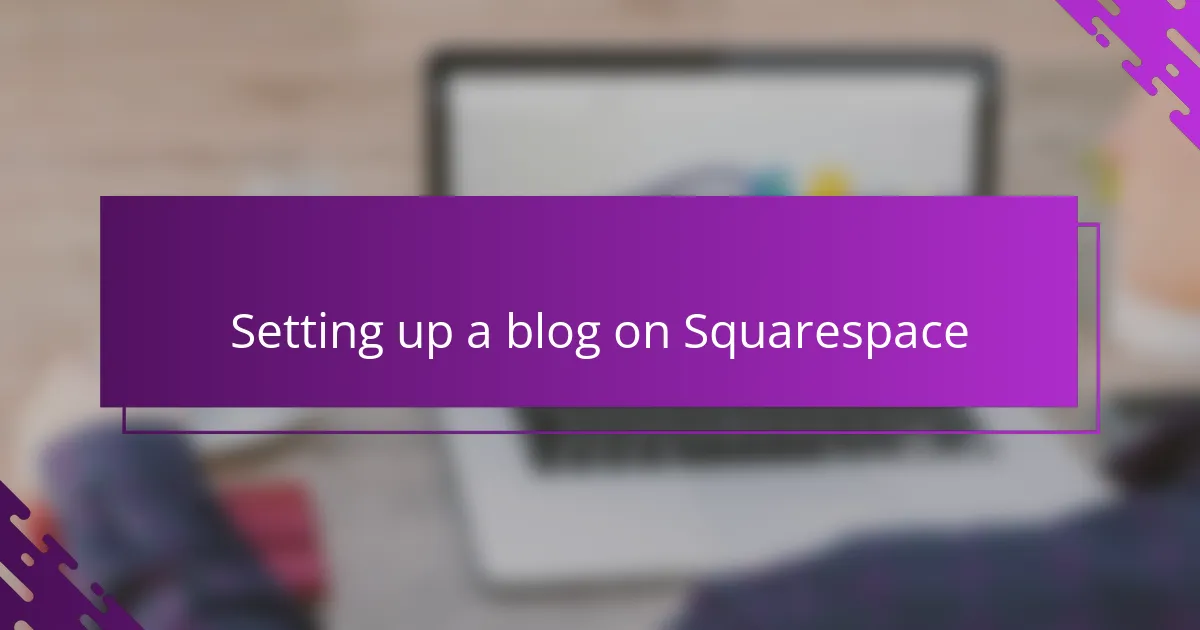
Setting up a blog on Squarespace
Setting up a blog on Squarespace was surprisingly straightforward for me. I remember clicking through the initial steps and feeling an immediate sense of clarity—no confusing jargon, just clear options guiding me through. Have you ever started a project feeling overwhelmed? Squarespace made that feeling disappear fast.
One thing that stood out during setup was how customizable the templates were without being intimidating. I could tweak fonts, colors, and layouts to match my personality without needing any design skills. It felt empowering to craft a space that looked uniquely mine in just a few clicks.
Also, integrating essential features like social sharing and email sign-ups happened effortlessly, which was a relief. I didn’t want to spend hours wrestling with plugins or add-ons. Don’t you think technology should make creative work easier? For me, Squarespace hit that sweet spot perfectly right from the start.

Design tips for Squarespace blogs
When it comes to designing my Squarespace blog, I found that simplicity is truly my best friend. Choosing a clean template and sticking to a cohesive color palette not only made my site look polished but also helped my words take center stage. Have you noticed how a cluttered design can distract from your message? That realization changed how I approached every design choice.
Another tip I swear by is using high-quality images that resonate with the tone of my posts. For me, pairing a compelling photo with each blog entry creates an invitation for readers to linger longer. It’s like setting a warm, welcoming atmosphere—don’t you want your blog to feel like a place people want to return to?
Finally, I recommend paying attention to typography because the right fonts can subtly shape how your content feels. Playing with font sizes and spacing helped me create a rhythm that matches my voice. Have you ever thought about how font style influences your mood when reading? That small detail made a big difference in making my blog feel more personal and engaging.
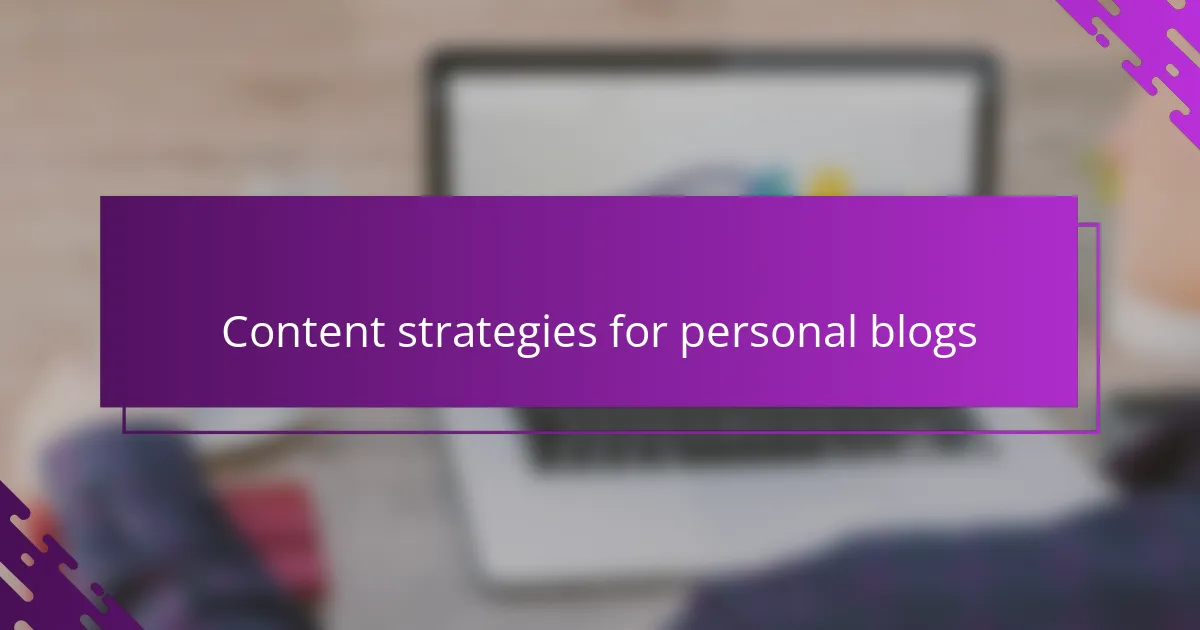
Content strategies for personal blogs
Content strategies for personal blogs often begin with authenticity—sharing stories that resonate on a real, human level. I found that when I write from genuine experience, my readers sense that honesty, which creates a quiet but powerful connection. Have you ever noticed how a heartfelt post can feel like a whispered secret passed between friends?
Another strategy I lean on is consistency, but not in a rigid way. For me, it’s about establishing a rhythm that feels natural, whether that’s weekly reflections or occasional deep dives into life’s complexities. Doesn’t having a pattern help your creativity too, by giving you a gentle nudge without pressure?
Finally, mixing formats—like combining everyday anecdotes with photo journals or quick thoughts—keeps the blog lively and engaging. I remember experimenting with this approach and realizing how much it refreshed both my writing and my readers’ interest. Have you tried switching things up in your blog to keep it feeling fresh?

Analyzing my experience with Squarespace
When I first started using Squarespace, I was honestly impressed by how fluid everything felt. The platform seemed to anticipate my needs, making transitions between writing, designing, and publishing almost seamless. Have you ever wished your tools just worked without you having to micromanage every detail? That was exactly my experience here.
However, I did encounter moments when I wished for a bit more flexibility—especially in customizing certain blog elements beyond the templates. It made me realize that while Squarespace aims for simplicity, sometimes that means sacrificing extensive control. Does ease of use sometimes come at the cost of creative freedom? For me, striking that balance took some trial and error.
Still, the overall experience made me feel supported as a blogger, especially when handling everything from one dashboard felt manageable rather than overwhelming. It was like having a reliable assistant who organizes the chaos behind the scenes, so I could focus on telling my stories. Isn’t that what we all want from a blogging platform?
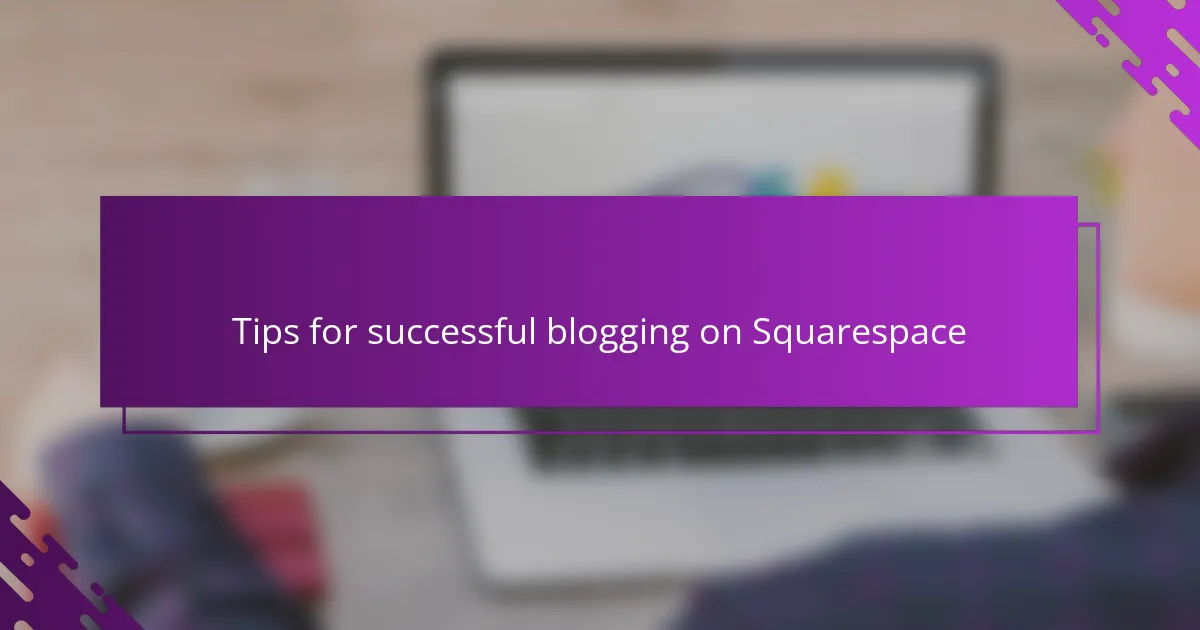
Tips for successful blogging on Squarespace
One tip I’ve found crucial for successful blogging on Squarespace is to take full advantage of the built-in scheduling tools. When I started, I used to write posts sporadically, which felt chaotic. But setting up a posting schedule within Squarespace helped me build consistency without stress—don’t you find that knowing when your next post goes live removes a huge weight?
Another thing that worked well for me was organizing my content with clear categories and tags. At first, I underestimated how important this was, but then I noticed readers stayed longer and explored more when they could easily find related posts. Have you ever landed on a blog where everything felt jumbled? Squarespace’s simple editing interface made setting up those structures a breeze, which in turn made my blog feel more welcoming.
Finally, I can’t stress enough the value of regularly checking your site’s analytics. When I started paying attention to which posts got the most engagement, it changed how I approached topics and even my writing style. Doesn’t it feel rewarding to see your words making an impact? For me, Squarespace’s analytics turned blogging into more than just sharing—it became an ongoing conversation with my readers.
